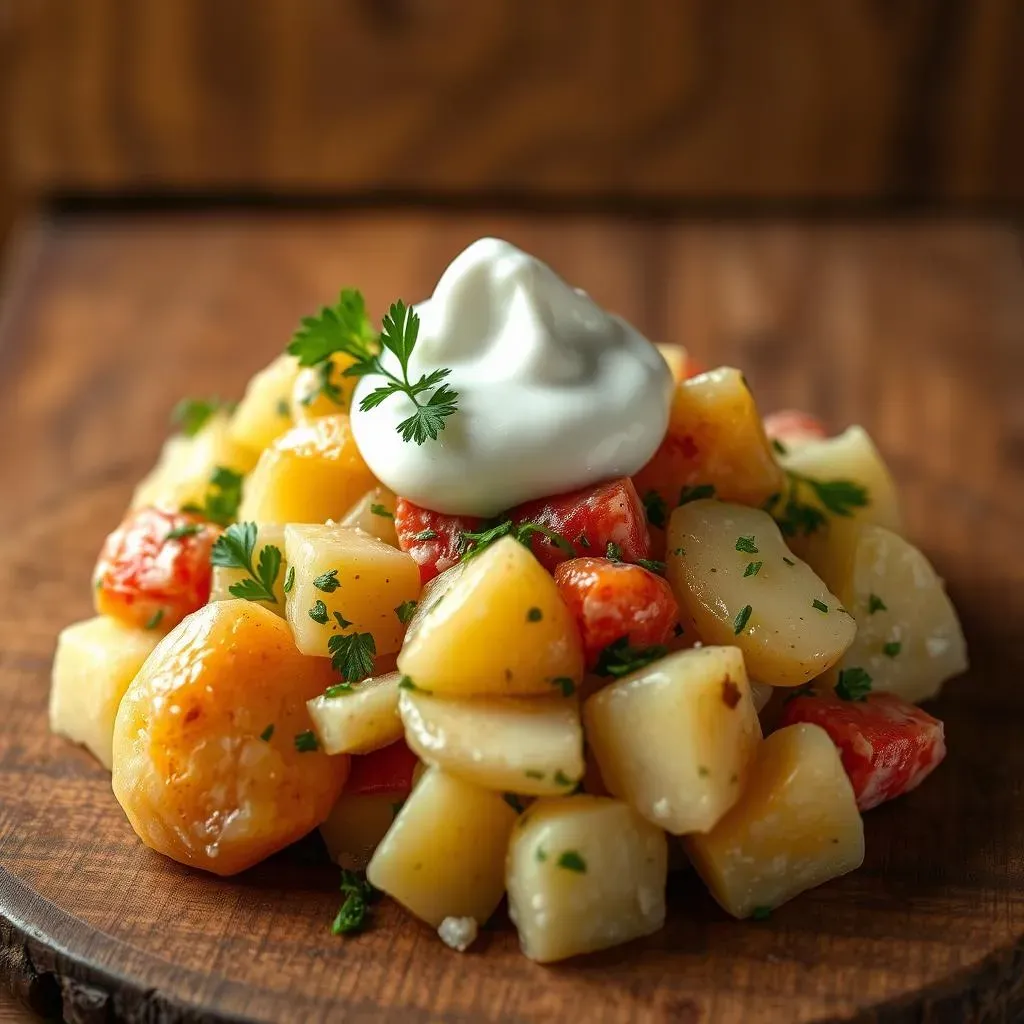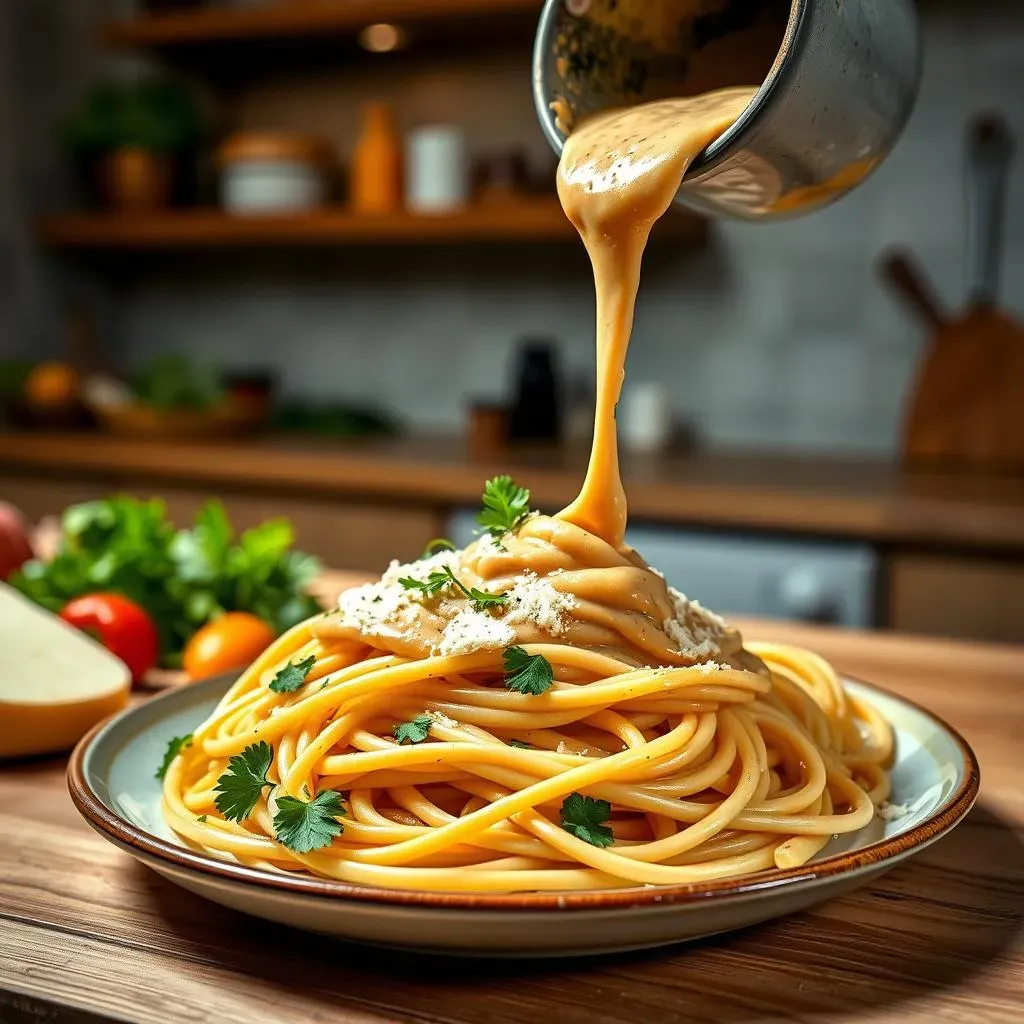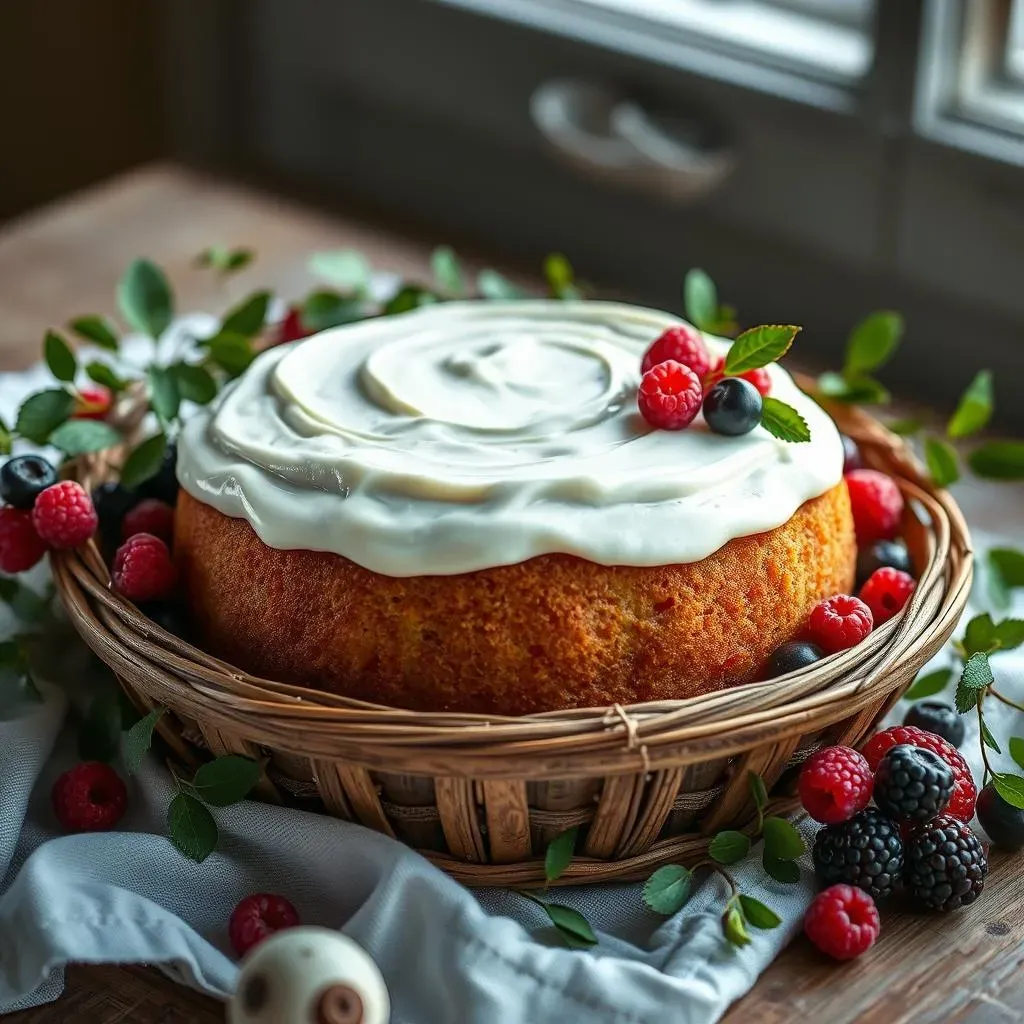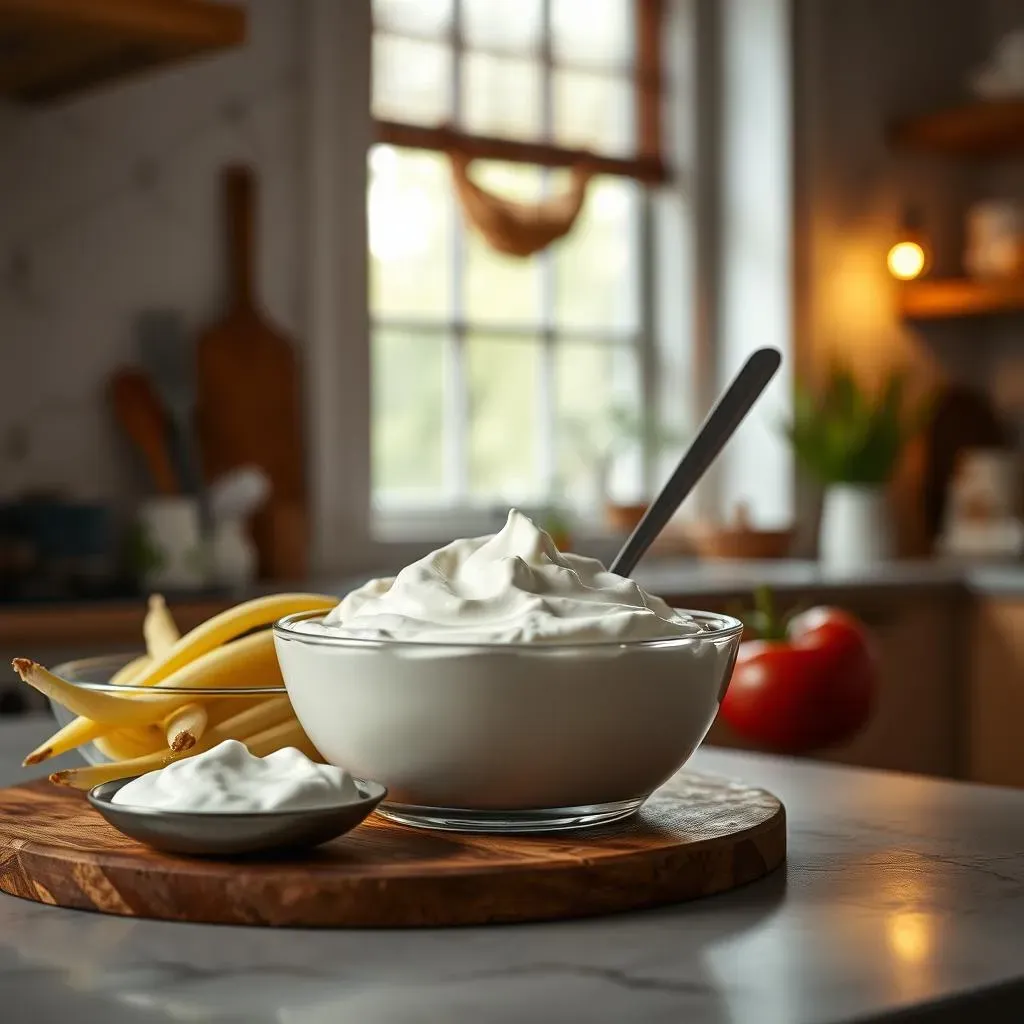Table of Contents
Ever found yourself staring into the fridge, recipe in hand, only to realize you're out of yogurt? It's a kitchen conundrum many of us face. But fear not, because substituting sour cream for yogurt is a simple swap that can save the day. This article will show you how to make this substitution work like a charm. We'll explore when using sour cream is a great idea, and when it's not. We'll guide you through the practical steps to make the swap, focusing on how it affects the taste and texture of your dishes. Plus, we'll give you some baking tips to ensure your cakes and muffins come out perfect. Finally, we'll highlight some common mistakes to avoid when substituting sour cream for yogurt so you won’t end up with a kitchen disaster. So, let’s get started and unlock the secrets to making this substitution work every time!
When to Reach for Sour Cream Instead of Yogurt

When to Reach for Sour Cream Instead of Yogurt
Thickening Power
Okay, so you're staring at a recipe that calls for yogurt, but all you've got is a tub of sour cream. Don't panic! Sour cream, especially the full-fat kind, is a champ at adding thickness to dishes. Think of it like a creamy superhero. If you're making a sauce or a dip and want a rich, dense consistency, then sour cream is your go-to. It's got that luxurious texture that can really elevate your dish. I remember once I was making a potato salad, and I was out of yogurt, so I used sour cream and it was a hit. The salad was extra creamy and everyone loved it.
But it’s not just about thickness, it’s also about tang. Sour cream has a distinct tang that can add a nice zing to your food. It's not as bright and acidic as yogurt, so it gives a different kind of flavor profile. If your recipe calls for a subtle tang, then sour cream works perfectly. This is especially true in things like creamy soups or stroganoff, where you want a bit of that sharpness to balance out the richness. It’s like adding a secret ingredient that makes everyone ask what you did differently.
Flavor Profile
Now, let's talk about flavor. Yogurt and sour cream aren't identical twins; they're more like cousins. Yogurt tends to have a brighter, more acidic tang, while sour cream leans towards a richer, slightly more mellow flavor. If you're making a dish where the yogurt's acidity is crucial, like a marinade for chicken, sour cream might not be the best match. However, if you're aiming for a creamy, smooth texture with a mild tang, then sour cream is a great substitute. I once tried to use sour cream in a tzatziki sauce. It wasn’t terrible, but it definitely lacked that vibrant kick I was expecting. So, keep in mind the kind of flavor you’re going for.
Another thing to consider is the fat content. Full-fat sour cream is going to be much richer and creamier than low-fat or non-fat yogurt. So, if you're trying to keep things light, then using a low-fat yogurt might be a better idea. However, if you’re looking for that indulgent, decadent feel, then sour cream is your friend. It’s all about balance. Think about what kind of richness and tang you want, and then choose accordingly. Sometimes, a little extra richness is exactly what a dish needs.
Characteristic | Yogurt | Sour Cream |
|---|---|---|
Texture | Lighter, thinner | Thicker, richer |
Tang | Brighter, more acidic | Milder, less acidic |
Fat Content | Varies, can be low-fat or non-fat | Typically higher fat |
Best Use | Marinades, dressings, smoothies | Dips, sauces, toppings |
How to Substitute Sour Cream for Yogurt: A Practical Guide

How to Substitute Sour Cream for Yogurt: A Practical Guide
The 1:1 Rule
Alright, let's get down to brass tacks. Substituting sour cream for yogurt is usually a pretty straightforward process. The golden rule? A one-to-one ratio. That means if your recipe calls for one cup of yogurt, you can swap it out with one cup of sour cream. It's that simple. Now, this works most of the time, especially in dips, sauces, and even some baking recipes. I remember the first time I tried it, I was making a creamy pasta sauce, and it came out perfectly. The texture was spot on, and the flavor was rich and delicious. It's like a kitchen hack that everyone should know.
However, it’s not always a perfect swap, so you gotta keep a few things in mind. For instance, if you're using a low-fat or non-fat yogurt, switching to full-fat sour cream will make your dish much richer and denser. Also, if the recipe relies heavily on the acidity of the yogurt (like in a marinade), the milder tang of sour cream might alter the flavor a bit. So, while the 1:1 rule is a great place to start, it's always good to taste as you go and adjust accordingly. Think of it as a starting point, not the finish line. It's like a map, it gets you where you want to go, but you might need to take a detour here and there.
Adjusting for Consistency
Now, let's talk about texture, because that's where things can get a little tricky. Sour cream is thicker than most yogurts, so if you're substituting it in a recipe where you want a lighter consistency, you might need to thin it out a bit. One easy way to do this is by adding a splash of milk or water until you reach the desired texture. I often use this trick when I'm making a salad dressing. A little bit of liquid can make a big difference, turning a thick dollop of sour cream into a smooth, pourable dressing. It's all about finding the right balance.
On the flip side, if your recipe needs a really thick consistency, like a dip or frosting, then sour cream is a great option as is. You might even want to use a full-fat sour cream for extra richness. Just remember that the fat content of your sour cream will impact the final product. I learned this the hard way when I tried to make a low-fat dip using fat-free sour cream. It was a total flop. It was watery and lacked that creamy richness I was hoping for. So, keep an eye on the fat content. It's like the secret weapon that can make or break your dish. It's all about finding the perfect balance of texture and flavor.
Substitution Factor | Action |
|---|---|
Consistency | Add milk or water to thin sour cream. |
Fat Content | Use full-fat for extra richness, low-fat for a lighter option. |
Acidity | Taste and adjust with lemon juice if needed. |
Baking with Sour Cream: Tips for Yogurt Substitutions

Baking with Sour Cream: Tips for Yogurt Substitutions
Moisture Magic
So, you're thinking about using sour cream instead of yogurt in your baking? Good move! Sour cream is a fantastic addition to cakes, muffins, and even quick breads because of the moisture it brings. It's like a secret weapon for keeping your baked goods super moist and tender. I remember the first time I used sour cream in a lemon cake—it was unbelievably moist and had this amazing melt-in-your-mouth texture. It's all thanks to the fat content of the sour cream, which helps to create a soft, velvety crumb. If you're tired of dry, crumbly cakes, then sour cream is your best bet.
But, here's the thing: not all sour cream is created equal. If you're using a low-fat sour cream, you might not get the same level of moisture as you would with full-fat. The higher the fat content, the more tender and moist your baked goods will be. So, keep that in mind when you're choosing your sour cream. It's like picking the right tool for the job. If you want a moist cake, go for the full-fat option. It’s a simple switch that can make a world of difference in your baking.
The Tang Factor
Now, let's talk about the tang. Sour cream, like yogurt, adds a subtle tang to your baked goods. This tanginess can help to balance out the sweetness and give your baked goods a more complex flavor. It's like adding a little bit of intrigue to your recipe. However, unlike yogurt, sour cream's tang is a bit milder, so it won't overpower your other flavors. This makes it a great option in recipes where you want a subtle tang, not an overly acidic flavor. I once made a batch of blueberry muffins using sour cream, and they had this amazing subtle tang that made them absolutely addictive.
Keep in mind that the tang will be more pronounced in recipes where the sour cream is a prominent ingredient. So, if you're making a sour cream coffee cake, for example, you'll definitely notice the tang. It's like the star of the show. But, if you're just using it as a substitute for yogurt, the tang will be more subtle. It’s all about understanding how different ingredients interact with each other and adjusting accordingly. Think of it as a way to add depth and dimension to your baking. It’s that little extra touch that makes people say, "Wow, what's your secret?"
Baking Aspect | Sour Cream Impact |
|---|---|
Moisture | Adds significant moisture, prevents dryness. |
Texture | Creates a tender, soft crumb. |
Flavor | Provides a subtle tang, balances sweetness. |
Fat Content | Use full-fat for best results, adjust for low-fat options. |
Adjusting Recipes
When substituting sour cream for yogurt in baking, it’s not just a matter of swapping one for one. You might need to tweak your recipe a bit to get the best results. For instance, if your recipe calls for a thinner yogurt, you might want to add a splash of milk to your sour cream to get the right consistency. It’s like fine-tuning an instrument to get the perfect sound. On the other hand, if your recipe is already quite liquidy, then using sour cream as is might be perfect. It’s all about paying attention to the details.
Also, keep in mind that sour cream can sometimes make your baked goods a bit denser. If you want a lighter, airier texture, then you might want to use a bit less sour cream or add a bit more leavening agent, like baking powder. It's like balancing a seesaw—you need to make sure everything is just right. I remember when I tried to make a cake using only sour cream and it came out a little dense. Next time I adjusted the recipe, and it was perfect. So, don't be afraid to experiment a little and find what works best for you. It's all part of the fun of baking.
Substituting Sour Cream for Yogurt: What to Avoid

Substituting Sour Cream for Yogurt: What to Avoid
When Acidity Matters
Alright, so we've talked about the good stuff, but let's get real: sour cream isn't a perfect stand-in for yogurt in every situation. One big thing to watch out for is acidity. Yogurt has a certain tang that comes from lactic acid, and that acidity can be super important in some recipes. Think about marinades, for example. If you're marinating chicken or fish, the acidity in yogurt helps to tenderize the meat and add flavor. Sour cream, on the other hand, is less acidic, so it won't have the same effect. I once tried to use sour cream in a yogurt-based marinade, and the chicken just didn't come out as tender or flavorful. It was a total bummer. So, if acidity is key, stick with yogurt or add a splash of lemon juice to your sour cream to boost the tang.
Also, consider recipes that rely on yogurt's acidity for leavening, like some cakes or quick breads. The acid in yogurt reacts with baking soda to create that light, fluffy texture. Sour cream doesn’t have the same level of acidity, so your baked goods might not rise as well. It’s like trying to start a fire with damp wood—it just won't work as well. So, if you're baking something that relies on that chemical reaction, either use yogurt or adjust your recipe accordingly. It's all about understanding the science behind the cooking, which I know can sound a bit daunting, but it makes a huge difference in your final product.
Low-Fat Faux Pas
Another trap to avoid is thinking that all sour creams are interchangeable. The fat content makes a huge difference. If you're using a recipe that calls for low-fat or non-fat yogurt, then switching to full-fat sour cream can totally throw off the balance. Full-fat sour cream is way richer and denser, so your dish might end up heavier than you intended. It's like trying to make a light, fluffy cloud using a brick—it's just not gonna happen. On the flip side, using fat-free sour cream as a substitute for full-fat yogurt might result in a dish that lacks flavor and richness. It's all about finding the right balance. I learned this lesson the hard way when I tried to make a healthy smoothie using fat-free sour cream—it tasted like sadness. So, consider the fat content and choose the right option for your recipe.
Also, don't assume that low-fat or fat-free versions of sour cream will always behave the same way as full-fat versions, especially when it comes to baking. They often have added stabilizers and thickeners that can mess with the texture and flavor of your baked goods. It's like trying to build a house with cardboard instead of wood—it just won't hold up. So, if you’re baking, stick with full-fat sour cream or adjust your recipe accordingly. It’s like having the right tools for the job, it makes a huge difference in the final result.
Mistake | Consequence | Solution |
|---|---|---|
Ignoring Acidity | Altered flavor, poor tenderization in marinades | Add lemon juice or use yogurt |
Fat Content Mismatch | Dish too heavy or lacking richness | Match fat content of yogurt |
Low-Fat Baking | Altered texture and flavor | Use full-fat or adjust recipe |
Hot Recipe Hazards
Finally, let's talk about cooking. While sour cream is a great addition to many hot dishes, it can also be a bit temperamental. If you're adding it to a hot recipe, especially one that's being cooked at high temperatures, you need to be careful. High heat can cause sour cream to curdle or separate, leaving you with a grainy, unpleasant texture. It’s like trying to mix oil and water—it just doesn’t work. I remember once I added sour cream to a hot soup, and it ended up looking like a sad, curdled mess. So, to avoid this, add sour cream at the very end of cooking, and make sure to stir it in gently over low heat.
Another tip is to temper the sour cream before adding it to the hot dish. This means mixing a small amount of the hot liquid into the sour cream to gradually warm it up, before adding it to the pot. It's like slowly easing your way into a hot bath—it prevents a shock to the system. This will help to prevent curdling and ensure that your dish stays smooth and creamy. It’s all about being gentle and patient. It's like nurturing a delicate flower—you need to treat it with care to get the best results.
The Final Scoop on Substituting Sour Cream for Yogurt
Substituting sour cream for yogurt doesn't have to be a kitchen gamble. With a little know-how, you can confidently swap these two ingredients and still whip up delicious dishes. Remember, it's all about understanding the differences in texture and fat content, and how they affect your recipe. Whether you're baking a cake or making a dip, knowing when to use sour cream and when to steer clear will give you the best results. So, go ahead and experiment, have fun, and don't be afraid to get a little creative in the kitchen. Happy cooking!